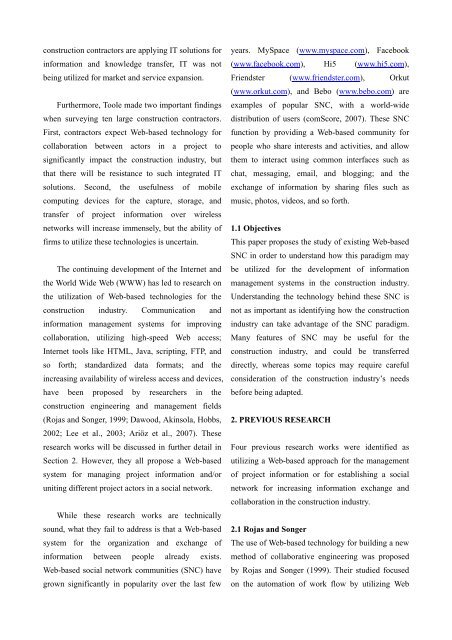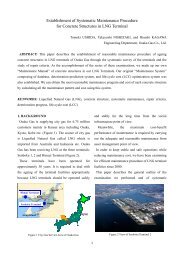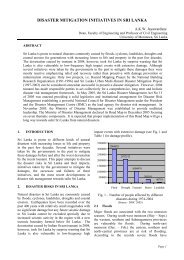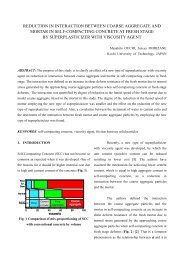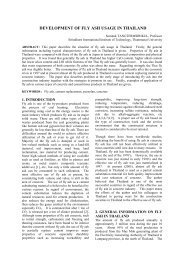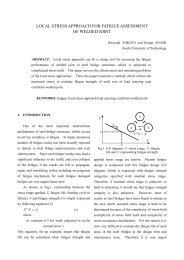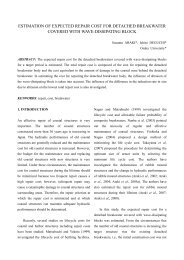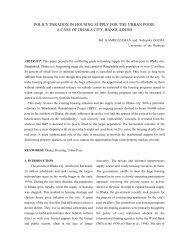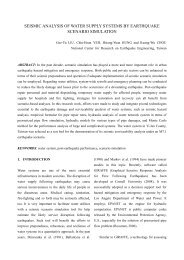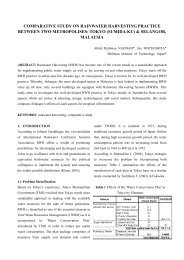PAPER FORMAT FOR THE INTERNATIONAL SYMPOSIUM on ...
PAPER FORMAT FOR THE INTERNATIONAL SYMPOSIUM on ...
PAPER FORMAT FOR THE INTERNATIONAL SYMPOSIUM on ...
You also want an ePaper? Increase the reach of your titles
YUMPU automatically turns print PDFs into web optimized ePapers that Google loves.
c<strong>on</strong>structi<strong>on</strong> c<strong>on</strong>tractors are applying IT soluti<strong>on</strong>s for<br />
informati<strong>on</strong> and knowledge transfer, IT was not<br />
being utilized for market and service expansi<strong>on</strong>.<br />
Furthermore, Toole made two important findings<br />
when surveying ten large c<strong>on</strong>structi<strong>on</strong> c<strong>on</strong>tractors.<br />
First, c<strong>on</strong>tractors expect Web-based technology for<br />
collaborati<strong>on</strong> between actors in a project to<br />
significantly impact the c<strong>on</strong>structi<strong>on</strong> industry, but<br />
that there will be resistance to such integrated IT<br />
soluti<strong>on</strong>s. Sec<strong>on</strong>d, the usefulness of mobile<br />
computing devices for the capture, storage, and<br />
transfer of project informati<strong>on</strong> over wireless<br />
networks will increase immensely, but the ability of<br />
firms to utilize these technologies is uncertain.<br />
The c<strong>on</strong>tinuing development of the Internet and<br />
the World Wide Web (WWW) has led to research <strong>on</strong><br />
the utilizati<strong>on</strong> of Web-based technologies for the<br />
c<strong>on</strong>structi<strong>on</strong> industry. Communicati<strong>on</strong> and<br />
informati<strong>on</strong> management systems for improving<br />
collaborati<strong>on</strong>, utilizing high-speed Web access;<br />
Internet tools like HTML, Java, scripting, FTP, and<br />
so forth; standardized data formats; and the<br />
increasing availability of wireless access and devices,<br />
have been proposed by researchers in the<br />
c<strong>on</strong>structi<strong>on</strong> engineering and management fields<br />
(Rojas and S<strong>on</strong>ger, 1999; Dawood, Akinsola, Hobbs,<br />
2002; Lee et al., 2003; Ariöz et al., 2007). These<br />
research works will be discussed in further detail in<br />
Secti<strong>on</strong> 2. However, they all propose a Web-based<br />
system for managing project informati<strong>on</strong> and/or<br />
uniting different project actors in a social network.<br />
While these research works are technically<br />
sound, what they fail to address is that a Web-based<br />
system for the organizati<strong>on</strong> and exchange of<br />
informati<strong>on</strong> between people already exists.<br />
Web-based social network communities (SNC) have<br />
grown significantly in popularity over the last few<br />
years. MySpace (www.myspace.com), Facebook<br />
(www.facebook.com), Hi5 (www.hi5.com),<br />
Friendster (www.friendster.com), Orkut<br />
(www.orkut.com), and Bebo (www.bebo.com) are<br />
examples of popular SNC, with a world-wide<br />
distributi<strong>on</strong> of users (comScore, 2007). These SNC<br />
functi<strong>on</strong> by providing a Web-based community for<br />
people who share interests and activities, and allow<br />
them to interact using comm<strong>on</strong> interfaces such as<br />
chat, messaging, email, and blogging; and the<br />
exchange of informati<strong>on</strong> by sharing files such as<br />
music, photos, videos, and so forth.<br />
1.1 Objectives<br />
This paper proposes the study of existing Web-based<br />
SNC in order to understand how this paradigm may<br />
be utilized for the development of informati<strong>on</strong><br />
management systems in the c<strong>on</strong>structi<strong>on</strong> industry.<br />
Understanding the technology behind these SNC is<br />
not as important as identifying how the c<strong>on</strong>structi<strong>on</strong><br />
industry can take advantage of the SNC paradigm.<br />
Many features of SNC may be useful for the<br />
c<strong>on</strong>structi<strong>on</strong> industry, and could be transferred<br />
directly, whereas some topics may require careful<br />
c<strong>on</strong>siderati<strong>on</strong> of the c<strong>on</strong>structi<strong>on</strong> industry’s needs<br />
before being adapted.<br />
2. PREVIOUS RESEARCH<br />
Four previous research works were identified as<br />
utilizing a Web-based approach for the management<br />
of project informati<strong>on</strong> or for establishing a social<br />
network for increasing informati<strong>on</strong> exchange and<br />
collaborati<strong>on</strong> in the c<strong>on</strong>structi<strong>on</strong> industry.<br />
2.1 Rojas and S<strong>on</strong>ger<br />
The use of Web-based technology for building a new<br />
method of collaborative engineering was proposed<br />
by Rojas and S<strong>on</strong>ger (1999). Their studied focused<br />
<strong>on</strong> the automati<strong>on</strong> of work flow by utilizing Web


